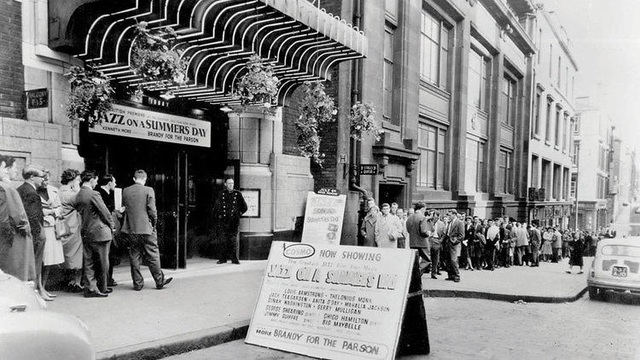
The Cosmo, Glasgow (uploaded by Granola) Creative Commons (Attribution) Licence via cinematreasures.org
In the early 1990s Annette Kuhn, then Reader in Film and Television Studies in the University of Glasgow, embarked on a study of popular cinema culture in the 1930s with the aid of a small grant from the Carnegie Trust for the Universities of Scotland. This involved reading all the film fan magazines that were published in Britain during the decade, an exercise that generated surprising insights into the era’s most popular films and stars as well as illuminating glimpses of the filmgoing ‘mentality’ of the time—what ‘going to the pictures’ felt like for those most closely involved, the cinemagoers themselves. Decades on, could this quintessential 1930s experience be retrieved in some way, and understood?
1990s Glasgow was an ideal time and place to seek answers to this question. In the interwar heyday of popular cinemagoing, the city boasted close to a hundred cinemas and could convincingly claim to have the largest number of cinema seats in Europe per head of population.[1] Furthermore, in the 1990s many of those who had enjoyed their youthful cinemagoing during the 1930s were still alive—and proved more than willing to share their memories.
Publicity in local media during 1992–including ‘Glasgow Times’ (26 April) and ‘The Glaswegian’ (2 May), as well as local radio–generated a modest but encouraging buzz of interest. In Autumn that year, Glasgow Film Theatre hosted a short season of six 1930s films, selected from what Annette Kuhn had learned from the contemporary film fan press were the UK’s most popular films and stars of the time (see GFT Flyer below).[2] The 3 December matinee screening of the Jessie Matthews vehicle Evergreen—with every seat in the GFT’s Cinema 2 taken–was followed by an open workshop in which 1930s filmgoers present were invited to share their cinemagoing memories and encouraged to complete a question sheet, leaving their contact details if they wished to be kept in touch with the project.[3]
Two years later, when Cinema Culture in 1930s Britain, courtesy of the Economic and Social Research Council, had been launched and staffed, Research Fellow Valentina Bold reached out to those among Annette Kuhn’s 1992 correspondents who had lived in Glasgow in the 1930s and were of an age likely to remember going to the cinema at the time. Contact was also made with previous contacts of the Research Fellow’s in care homes for the elderly, reminiscence groups, local history groups, and suchlike.
Between November 1994 and March 1995 pilot interviews were conducted with forty-four individuals who met the interviewer on their own, in couples, or in groups. From these, seventeen core informants were identified, with years of birth ranging from 1902 to 1927 (selection was based roughly on UK 1930s social class demographics and the gender profile of 1930s cinemagoers).[4] Of the seventeen, ten were female and seven male; and ten were occupationally working class and seven middle class. All the core informants were interviewed at least twice, and the Glasgow interview fieldwork was completed by April 1995.[5]
Interviews involving all Glasgow core informants and three non-core informants have been transcribed and audio-synced (these are listed below, with links to informants’ home pages); and a further four interviews with non-core informants have now been transcribed.
- Norman MacDonald
- Mary McCusker
- Thomas McGoran
- Sheila McWhinnie
- Nancie Miller*
- Tony (Anthony) Paterson*
- Helen Smeaton
- Tom (Thomas) and Margaret Walsh
- Margaret Young and Mollie Stevenson
Glenwood Lodge care home
Hamiltonhill Day Centre
* Non-core informants
Glasgow Memorabilia and Links
Listing of Glasgow cinemas (alphabetical)
Listing of Glasgow cinemas (by district)
Flyer for GFT Screenings
Scottish Cinemas and Theatres
Early Cinema in Scotland (University of Glasgow website)
Publications related to 1930s cinemagoing in Glasgow:
Cameron, C. (1943). Disinherited Youth: a Survey, 1936-1939. Fife, Carnegie United Kingdom Trust.
Louden, T. (1983). The Cinemas of Cinema City. Glasgow.
McBain, J. (1985). Pictures Past: Scottish Cinemas Remembered. Edinburgh, Moorfoot Publishing.
Peter, B. (1996). 100 Years of Glasgow’s Amazing Cinemas. Edinburgh, Polygon.
Scottish Film Council (1946). Fifty Years at the Pictures. Glasgow, Scottish Film Council.
Notes
[1] In 100 Years of Glasgow’s Amazing Cinemas, Bruce Peter lists 169 film exhibition venues in operation in the city from 1896. Cinema Treasures (Movie Theaters in Glasgow, Scotland – Cinema Treasures) includes ninety-seven (accessed 30 January 2022).
[2] The ‘Popular Cinema in the 1930s’ season featured One Hundred Men and a Girl (1937); Cavalcade (1933); Sunshine Susie (1931); The Littlest Rebel (1935); Evergreen (1934); and The Ghost Goes West (1935).
[3] The discussion was recorded and has since been synced and transcribed.
[4] The number of Glasgow core informants is given as sixteen in the Research Fellow’s April 1995 report, because one half of a married couple was not counted.
[5] Valentina Bold, ‘Report on Pilot Project: Cinema Culture in 1930s Britain’, 13 April 1995. The report reflects on fieldwork practices and interview techniques and sets out recommendations for future CCINTB fieldwork.